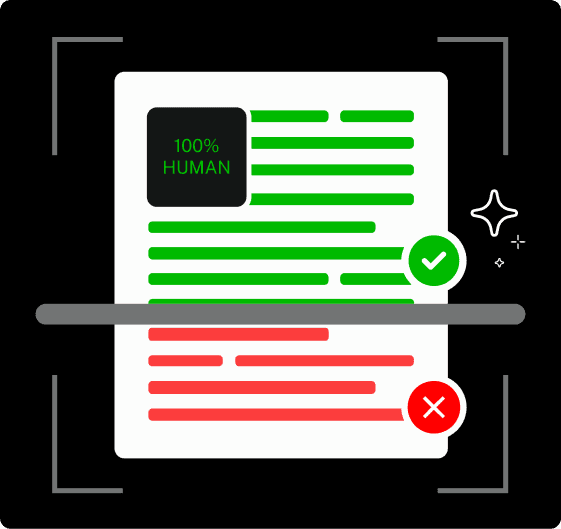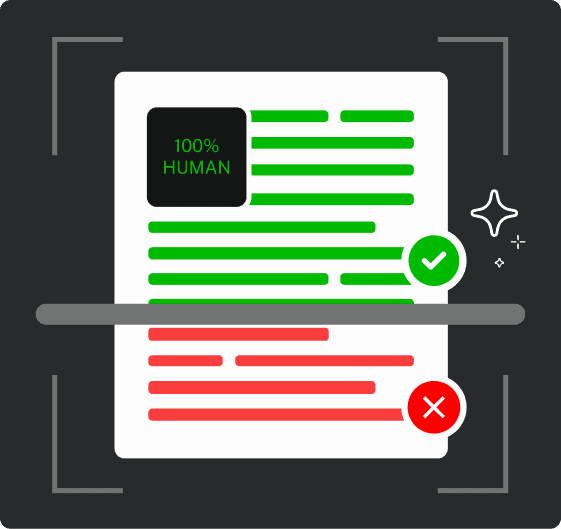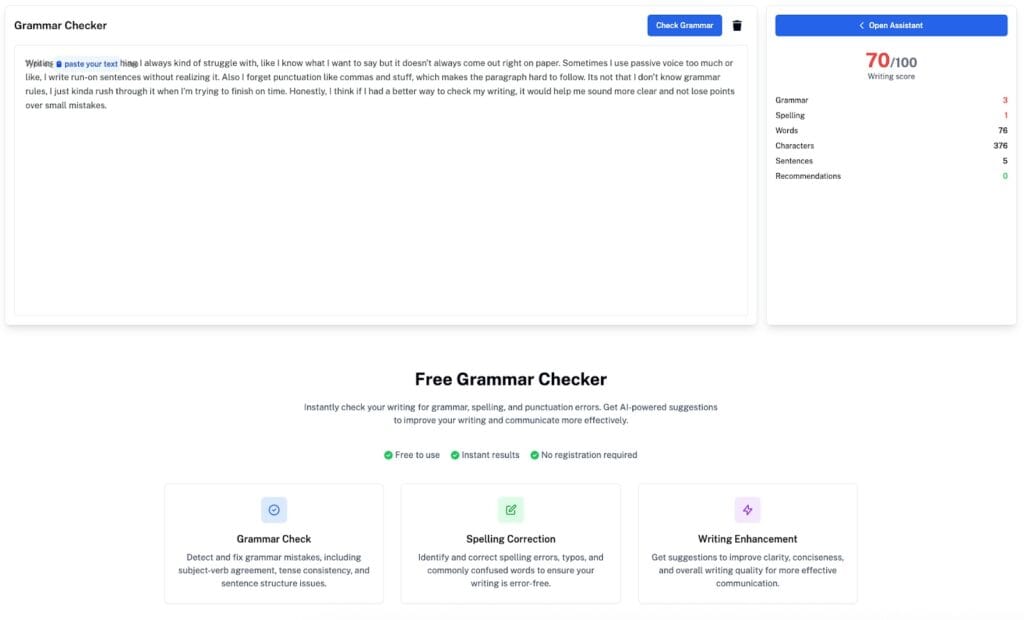Does it really matter if you use active or passive voice? Not exactly, but knowing the difference can shape your tone and avoid confusion.
Whether you’re writing an essay for school or building content for work, grammar matters.
Active voice is more suitable for direct and lively writing, while passive voice is useful in formal or scientific reports where the person or thing carrying out the action isn’t very important.
Follow along as we guide you to becoming a better writer.
Key Takeaways
- Active voice puts the subject first, making sentences more direct. It’s ideal for everyday writing or when providing instructions.
- Passive voice shifts the focus to the object or action. It works well when the doer is unknown, less important, or better left out.
- To change passive to active, identify the subject performing the action and move it to the front. Example: The book was written by the author (passive) → The author wrote the book (active). To go from active to passive, make the object the focus and adjust the verb form.
What Is Active Voice?
Active voice is when the subject of the sentence does the action.
It’s preferred when you want your sentences to be simple and direct to the point. Active voice also makes your tone sound more confident.
Here’s the active voice structure:
Subject + Verb + Object


Never Worry About AI Detecting Your Texts Again. Undetectable AI Can Help You:
- Make your AI assisted writing appear human-like.
- Bypass all major AI detection tools with just one click.
- Use AI safely and confidently in school and work.
Examples:
- “The manager approved the budget.”
- “She delivered the report on time.”
- “The dog chased the ball.”
In each case, the subject (the manager, she, the dog) is the one doing something. They’re in control of the action.
What Is Passive Voice?
On the other side, passive voice flips the focus. Instead of the subject doing the action, the action happens to the subject.
In creative writing, it’s often used if you prefer your statement to sound like the doer of the action is unknown or doesn’t need to be mentioned.
Here’s how the passive voice is structured:
Object + Verb (form of “to be”) + Past participle + (by subject)
Examples:
- “The budget was approved by the manager.”
- “The report was delivered on time by her.”
- “The ball was chased by the dog.”
As you can see (compared to active voice), the meaning of each statement stays the same.
But the tone changes. Passive voice puts the spotlight on the result or the object, not the person doing the action.
Just be aware that it can sound wordy or vague when overused, so use it sparingly or only during ideal moments.

Image Source: Unsplash
Active vs Passive Voice: Key Differences
Knowing the difference between active and passive voice can change how your writing comes across. Here are the main contrasts to look out for:
Focus
We already tackled this, but to reiterate as this is the key definition, use active voice if you want to focus on the subject doing the action.
Meanwhile, go with passive voice if the focus is on the action (it’s even possible to skip the subject altogether).
Example:
- Active: “The assistant scheduled the meeting.”
- Passive: “The meeting was scheduled by the assistant.”
Clarity
Active voice is often clearer and easier to understand. Passive voice can make sentences feel less direct or more formal.
Example:
- Active: “We mailed your package.”
- Passive: “Your package was mailed.”
Both are fine as their own, but the first one sounds more personal and to the point.
Tone
Your tone in writing gives your words attitude. Active voice feels more confident.
Passive voice may be better if you want to be more formal, especially in academic writing or customer communication where tone matters.
Passive voice is also preferred to add mystery or give a sentence more character.
Example:
- Active: “She slammed the door shut.”
- Passive: “The door was slammed shut.” (Who did it?)
Length
Passive voice tends to be longer and more complex. In most cases, shorter means clearer, which makes active voice the arguably more popular voice in everyday writing.
In contrast, passive voice can give you more flexibility and control with your pacing.
That flexibility also helps when calculating your book’s length (or any other work) before writing, letting you know when to slow down the rhythm or add detail without breaking the flow.
- Active: “She painted the mural in three days.”
- Passive: “The mural was painted in three days — a tribute to her late father’s memory.”
As you can see, passive voice gives you room to develop a more emotional tone and add on to a single statement without having to cut it into multiple sentences.

Have an ongoing project, and need an expert to check it?
The Undetectable AI Grammar Checker is free to use and instantly checks your writing for grammar, spelling, and punctuation issues.
You’ll also get AI-powered suggestions to help you improve clarity, fix awkward phrasing, and write more effectively.

For school projects, you can also ask our free Undetectable AI Chat to help you brainstorm, structure your thoughts, and give you a solid head start, all delivered in a way that stays authentic and true to your voice.
When to Use Active Voice
If you’re aiming for clarity and a strong tone, active voice is often your best bet.
Use active voice when you want to:
- Keep things simple and to the point: If you’re writing an email or giving directions, active voice avoids confusion.
- Highlight the person or group doing the action: For example, if your team finished a major project, it’s more natural to say something like, “We delivered the results” than “The results were delivered.”
- Add energy and urgency: News articles, resumes, and instructionals all benefit from a tone that sounds like you’re in control and have authority on the matter.
- Make messages feel more personal: Active voice helps your reader connect to the person behind the words. For this reason, it’s often used in writing and social posts.
WhenVoice
With passive voice, you can more freely express the way you write. It can be more indirect, but this gives you more control as to how something should be perceived.
Use passive voice when you want to:
- Create a sense of formality or neutrality. In academic writing, you’ll often see phrases like “The study was conducted…” rather than “We conducted the study.” It keeps the focus on the facts, not the personal emphasis.
- Soften blame or criticism. Instead of saying, “You forgot to attach the file,” it might be more diplomatic to say, “The file wasn’t attached.” This can be helpful in customer service, HR communication, or delicate emails.
- Control tone and pacing. Passive voice naturally slows down your story, which can be useful in more reflective writing or when setting a serious tone.
- Emphasize results over action. If it doesn’t matter who did something, or if you’re purposely withholding a specific detail, passive voice helps. Example: “The painting was restored in 1972.” The restorer isn’t the focus here. This gives complete focus to the painting.
Remember that passive voice is intentional. And when you understand how to use it, you can shape how your message lands with your audience.

Image Source: Pexels
How to Change Passive Voice to Active Voice (and Vice Versa)
Switching between voices changes what you emphasize and how your message sounds.
Passive Voice to Active Voice
Let’s say you wrote this:
“The proposal was submitted late.”
It’s passive, and the subject is missing. Who submitted it?
To make it active, add the subject back in:
“The intern submitted the proposal late.”
Sometimes, going active clarifies accountability or tightens the sentence. But passive voice can be a better fit if you want to be diplomatic or vague on purpose.
Remember these steps to change passive voice to active voice:
- Find the action: Look for the verb and what’s being done.
Example: “The documents were submitted.”
The action here is “submitted.” - Identify who did it: Passive voice often hides the subject. Ask, who’s doing this? In this case, it’s the intern.
- Reorder the sentence: Put the subject first, followed by the verb, then the object. New sentence: “The intern submitted the documents.”
- Remove unnecessary “to be” verbs: That includes was, were, is, are, will be, has been.
Active Voice to Passive Voice
Now, let’s reverse it.
Say you wrote:
“Marketing ran the campaign.”
That’s fine. But maybe you want to highlight the result over who did it.
Instead, you could say:
“The campaign was successfully run and completed in two weeks.”
This time, the focus is on the achievement itself, not the department.
Take note of these steps to change active voice to passive voice:
- Find the object of the sentence: That’s what’s receiving the action.
Example: “The manager approved the request.”
The object is “the request.” - Make the object your new subject: New sentence is “The request was approved.”
- Use the correct “to be” verb + past participle: That depends on tense:
- “was approved” (past)
- “is approved” (present)
- “will be approved” (future)
- Add “by [subject]” if needed, or leave it out.
“The request was approved by the manager.”
When choosing between active and passive, ask:
- Who or what do I want to spotlight?
- Do I need to sound formal, soft, or more direct?
- Am I aiming for brevity or a more reflective tone?
One voice isn’t better than the other. It’s about choosing the one that fits the moment.
It can be confusing at first, especially if you’re writing more complex sentences.
To help, Undetectable AI Chat for real-time sentence transformations. It’s a great way to sharpen your writing on the spot.
Try these examples on your own and use the free AI Chat to see if your sentence flows the way it should:
Active to Passive:
- The dog chased the squirrel across the backyard.
- The marketing team launched a campaign that reached over a million users in just two days.
Passive to Active:
- The museum exhibit was designed by a team of international artists.
- A new software update was released last week to address the security vulnerabilities reported by users.
Undetectable AI gives you instant feedback and helps transform your own sentences.
Detect AI-generated content and humanize it effortlessly—get started below.
FAQs
Is passive voice always bad?
No, passive voice isn’t bad, but it depends on your goal.
It’s used intentionally, so when writing, know when you want to shift focus, create a formal tone, or when the subject is unknown or unimportant.
Can you use both voices in the same paragraph?
Yes, and you should do this if it fits your purpose.
Switching between active and passive voice can give your writing style variety, and helps with tone, clarity, and emphasis.
How can I spot passive voice quickly?
Look for a form of “to be” (was, were, is, etc.) followed by a past participle (e.g., was written).
Often, the subject appears after the verb, or isn’t there at all.
What’s the easiest way to learn the difference?
Practice rewriting sentences both ways. Ask: Who is doing the action?
If it’s clear and upfront, it’s likely active. If it’s hidden, secondary, or focuses more on the result, it’s most likely passive.
Active and Passive Voice: Find the Voice That Fits Your Message
Whatever you’re planning to write, understanding the difference between active and passive voice gives you more control.
It’s not about always choosing one over the other. It’s about knowing when and why each works best.
Once you spot the difference, you’ll start writing with more intention and require fewer edits.
And to guide you, tools like Undetectable AI can support your growth. Write confidently, stay in control, and let AI sharpen your voice.
